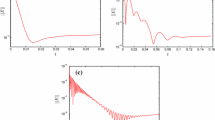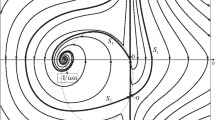Abstract
We study the positive stationary solutions of a standard finite-difference discretization of the semilinear heat equation with nonlinear Neumann boundary conditions. We prove that, if the diffusion is large enough, then there exists a unique solution of such a discretization, which approximates the unique positive stationary solution of the boundary-value problem under consideration. Furthermore, in this case we exhibit an algorithm computing an ε-approximation of such a solution by means of a homotopy continuation method. The cost of our algorithm is polynomial in the number of nodes involved in the discretization and the logarithm of the number of digits of approximation required.
Similar content being viewed by others
References
Allgower E, Georg K (1990) Numerical continuation methods: an introduction. Springer Ser. Comput. Math., vol 13. Springer, New York
Allgower E, Bates D, Sommese A, Wampler C (2006) Solution of polynomial systems derived from differential equations. Computing 76(1–2): 1–10
Andreu F, Mazon J, Toledo J, Rossi J (2002) Porous medium equation with absorption and a nonlinear boundary condition. Nonlinear Anal 49(4): 541–563
Ascher U, Mattheij R, Russell R (1995) Numerical solution of boundary value problems for ordinary differential equations. Classics in applied mathematics, vol 13. SIAM, Philadelphia
Bandle C, Brunner H (1998) Blow-up in diffusion equations: a survey. J Comput Appl Math 97(1–2): 3–22
Bebernes J, Eberly D (1989) Mathematical problems from combustion theory. Applied mathematical sciences, vol 83. Springer, New York
Blum L, Cucker F, Shub M, Smale S (1998) Complexity and real computation. Springer, New York
Bonder JF, Rossi J (2001) Blow-up vs. spurious steady solutions. Proc Am Math Soc 129(1): 139–144
Cannon J (1984) The one-dimensional heat equation. Cambridge University Press, Cambridge
Castro D, Giusti M, Heintz J, Matera G, Pardo L (2003) The hardness of polynomial equation solving. Found Comput Math 3(4): 347–420
Chipot M, Quittner P (2004) Equilibria, connecting orbits and a priori bounds for semilinear parabolic equations with nonlinear boundary conditions. J Dyn Differ Equ 16(1): 91–138
Chipot M, Fila M, Quittner P (1991) Stationary solutions, blow up and convergence to stationary solutions for semilinear parabolic equations with nonlinear boundary conditions. Acta Math Univ Comenian 60(1): 35–103
De Leo M, Dratman E, Matera G (2004) On the numerical solution of certain nonlinear systems arising in semilinear parabolic PDEs. Anales JAIIO (Jornadas Argentinas de Informática e Investigación Operativa) 33
De Leo M, Dratman E, Matera G (2005) Numeric vs. symbolic homotopy algorithms in polynomial system solving: a case study. J Complexity 21(4): 502–531
Deuflhard P, Bornemann F (2002) Scientific computing with ordinary differential equations. Texts in applied mathematics, vol 42. Springer, New York
Dratman E, Matera G (2008) Discrete vs. continuous stationary solutions for semilinear parabolic equations. In: Busch E et al (eds) Proceedings of the IV Congreso Internacional de Matemática Aplicada a la Ingenierí a, In-Mat 2008, Buenos Aires, August 2008
Dratman E, Matera G, Waissbein A (2009) Robust algorithms for generalized Pham systems. Comput Complex 18(1): 105–154
Duvallet J (1990) Computation of solutions of two-point boundary value problems by a simplicial homotopy algorithm. In: Allgower E, Georg K (eds) Computational solution of nonlinear systems of equations. Lectures Appl Math, vol 26 Amer Math Soc, Providence, pp 135–150
Fiedler B, Gedeon T (1999) A Lyapunov function for tridiagonal competitive-cooperative systems. SIAM J Math Anal 30(3): 469–478
Gilding B, Kersner R (2004) Travelling waves in nonlinear diffusion-convection reaction. Birkhäuser, Basel
Gomez JL, Marquez V, Wolanski N (1993) Dynamic behaviour of positive solutions to reaction-diffusion problems with nonlinear absorption through the boundary. Rev Un Mat Argentina 38: 196–209
Grindrod P (1996) The theory and applications of reaction-diffusion equations: patterns and waves. Clarendon Press, Oxford
Kacewicz B (2002) Complexity of nonlinear two-point boundary-value problems. J Complexity 18: 702–738
Keller H (1976) Numerical solution of two point boundary value problems. SIAM, Philadelphia
Levine H (1990) The role of critical exponents in blow up theorems. SIAM Rev 32: 262–288
Malajovich G, Rojas J (2004) High probability analysis of the condition number of sparse polynomial systems. Theor Comput Sci 315(2–3): 525–555
Meurant G (2000) Gaussian elimination for the solution of linear systems of equations. In: Ciarlet P, Lions J (eds) Handbook of numerical analysis, vol VII. North-Holland, Amsterdam, pp 3–170
Murray J (2002) Mathematical biology, vol 1: an introduction. Interdisciplinary applied mathematics, vol 17. Springer, New York
Ortega J, Rheinboldt W (1970) Iterative solutions of nonlinear equations in several variables. Academic Press, New York
Pao C (1992) Nonlinear parabolic and elliptic equations. Plenum Press, New York
Pardo L (2000) Universal elimination requires exponential running time. In: Montes A (ed) Computer algebra and applications. Proceedings of EACA–2000, Barcelona, Spain, September 2000, pp 25–51
Pearce C, Pecǎrić J (2000) Inequalities for differentiable mappings with application to special means and quadrature formulæ. Appl Math Lett 13(2): 51–55
Quittner P (1993) On global existence and stationary solutions for two classes of semilinear parabolic problems. Comment Math Univ Carolin 34(1): 105–124
Rodrí guez-Bernal A, Tajdine A (2001) Nonlinear balance for reaction-diffusion equations under nonlinear boundary conditions: dissipativity and blow-up. J Differ Equ 169(2): 332–372
Rossi J (1998) The blow-up rate for a semilinear parabolic equation with a nonlinear boundary condition. Acta Math Univ Comenian (NS) 67(2): 343–350
Samarskii A, Galaktionov V, Kurdyumov S, Mikhailov A (1995) Blow-up in quasilinear parabolic equations. de Gruyter Exp Math, vol 19. de Gruyter, Berlin
Smillie J (1984) Competitive and cooperative tridiagonal systems of differential equations. SIAM J Math Anal 15(3): 530–534
Smith H (1995) Monotone dynamical systems: an introduction to the theory of competitive and cooperative systems. Math. Surveys Monogr., vol 41. Amer Math Soc, Providence, RI
Strang G, Fix G (1973) An analysis of the finite element method. Prentice-Hall, Englewood Cliffs
Walter W (1970) Differential and integral inequalities. Ergeb. Math Grenzgeb, vol 55. Springer, Berlin
Walter W (1998) Ordinary differential equations. Grad. Texts in Math, vol 182. Springer, New York
Watson L (1980) Solving finite difference approximations to nonlinear two-point boundary value problems by a homotopy method. SIAM J Sci Stat Comput 1(4): 467–480
Author information
Authors and Affiliations
Corresponding author
Additional information
Communicated by D. Saupe.
Some of the results presented here were first announced at the IV Congreso Internacional de Matemática Aplicada a la Ingeniería, In-Mat 2008 (Buenos Aires, August 2008) (see [16]).
Rights and permissions
About this article
Cite this article
Dratman, E., Matera, G. On the solution of the polynomial systems arising in the discretization of certain ODEs. Computing 85, 301–337 (2009). https://doi.org/10.1007/s00607-009-0046-7
Received:
Accepted:
Published:
Issue Date:
DOI: https://doi.org/10.1007/s00607-009-0046-7
Keywords
- Two-point boundary-value problem
- Finite differences
- Neumann boundary condition
- Stationary solution
- Homotopy continuation
- Polynomial system solving
- Condition number
- Complexity




